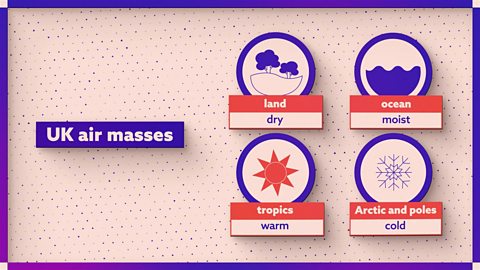Which factors affect local weather conditions?
Quick version
Local weather conditions are affected by the following factors:
- latitude - increasing latitude (moving from the Equator towards the poles) reduces temperature
- relief - increasing altitude (height) decreases temperature
- aspect - in the northern hemisphere, south-facing slopes receive more sun and are warmer than north-facing slopes
- distance from sea - locations near the sea have smaller temperature ranges, with milder winters and cooler summers
Learn in more depth
How does latitude affect the weather?
Temperatures drop the further an area is from the Equator due to the curvature of the Earth.
In areas closer to the poles, sunlight has a larger area of atmosphere to pass through and loses more energy before it reaches the Earth.
And the Sun is at a lower angle in the sky. This means its energy is spread over a wider area, and so does not bring as much heat as it does nearer the Equator.
As a result, temperatures are cooler.
The changing tilt of the Earth has a bigger effect on places at higher latitudes:
- in summer, higher latitudes in the northern hemisphere have longer daylight hours with more direct sunlight
- in winter, higher latitudes in the northern hemisphere have very short daylight hours and weaker sunlight
Locations at higher latitudes have much bigger seasonal changes.
The difference in daylight hours and strength of sunlight is much less at lower latitudes. Locations nearer the Equator have less varied climates with less seasonal change.
How does latitude affect the UK's climate?
In summer, latitudeHow far north or south somewhere is. Latitude is measured in degrees. The lowest latitude is on the Equator (0°). High latitudes are at the North Pole (90° north) and South Pole (90° south) is the main factor influencing UK climate because the Northern Hemisphere is tilted towards the Sun. This means solar radiation is more directly overhead and more intense bringing more heat.
However, in winter the UK is tilted away from the Sun, which means it has less influence. The prevailing winds blowing across the North Atlantic Drift ocean current have more influence in making the UK warmer than other places on the same latitude.
How does relief affect local climate?
In general, higher hills and mountains are colder than lower, flatter land.
Locations at a higher altitudeThe height of the land, measured in relation to sea level. have colder temperatures. At higher altitudes, air is thinner. There are fewer gas molecules to absorb and store heat, , which makes it very difficult for heat to be transferred between the molecules as they are further apart.
Temperature usually decreases by 1°C for every 100 metres in altitude.
How does relief affect local climate in the UK?
In the UK, prevailing windThe prevailing wind is the most frequent wind direction a location experiences. In Britain, the prevailing wind is from the South West, which brings warm, moist air from the Atlantic Ocean.come from the southwest and west. They bring moist air from over the Atlantic Ocean.
Many areas along the west of Great Britain, like the Highlands of Scotland, are hilly or mountainous.
- prevailing winds blow moist air upwards when it meets hills and mountains
- as the air rises it cools and can hold less moisture
- clouds form bringing precipitation
- once the air passes over high ground it sinks back down over lower ground
- the air warms and can hold more moisture
- this creates a rain shadow - an area which normally has drier weather.
Relief rainfall
Relief rainfall tends to bring:
- wetter weather to the west of Great Britain
- drier weather to the east
How does aspect affect the weather?
Aspect means which direction the slope of land is facing.
In the northern hemisphere, land that is south-facing receives more direct sunlight. Land that is north-facing receives less direct sunlight. It may often be in shade, especially in winter when the sun is at a lower angle.
South-facing slopes may also be warmed by winds from the south, whereas north-facing slopes are more exposed to cold northerly winds.
In the UK:
- slopes that face south tend to be warmer and sunnier
- slopes that face north tend to be colder with less sun
How does distance from the sea affect the weather?
Oceans heat up and cool down much more slowly than land. This means that coastal locations tend to be cooler in summer and warmer in winter than places inland at the same latitudeHow far north or south somewhere is. Latitude is measured in degrees. The lowest latitude is on the Equator (0°). High latitudes are at the North Pole (90° north) and South Pole (90° south) and altitudeThe height of the land, measured in relation to sea level..
Glasgow, for example, is at a similar latitude to Moscow, but is much milder in winter because it is nearer to the coast than Moscow.

Image caption, Glasgow, Scotland
Places near the coast tend to be cooler in summer and milder in winter. Glasgow is near the coast so it doesn't usually get extreme temperatures in summer (left) or winter (right). Although people who live in or near Glasgow might disagree! (Elizabeth Leyden / Chris James / Alamy Stock Photo)
Image caption, Moscow, Russia
Although Moscow in Russia has a similar line of latitude to Glasgow, it is much further away from the coast. Land heats up and cools down much more quickly than water does so places inland, like Moscow, tend to be hotter in the summer and colder in winter. (Nikolay Vinokurov / Alamy Stock Photo)
1 of 2
Quiz
Recap what you have learned
Latitude - places closer to the Equator are usually warmer, and places nearer to the North Pole and South Pole are colder.
- sun passes through more atmosphere at high latitudes, so loses more energy before it reaches the ground
- sun is spread over a wider area at high latitudes, so its energy is spread more thinly over a wider area
- locations at higher latitudes have more seasonal changes in weather
Relief - places located on flat low-lying land are warmer and places higher up, ie mountains, are colder and wetter.
- air is thinner at higher altitude so it can hold less moisture
- in the UK, prevailing winds from the southwest and west bring relief rainfall to higher western areas, and drier weather to lower eastern areas
Aspect - in the northern hemisphere, places which are south-facing are warmer and places which are north-facing are colder.
- south-facing slopes receive more sunlight
- north-facing slopes are more exposed to cold northerly winds
Distance from the sea - places nearer to the sea are mild and wet, and places further from the sea are drier, but temperatures are more extreme.
- water takes longer to heat up, keeping areas near the sea cooler in summer
- water takes longer to cool down, keeping areas near the sea milder in winter
More on Weather systems
Find out more by working through a topic
- count3 of 6

- count6 of 6
